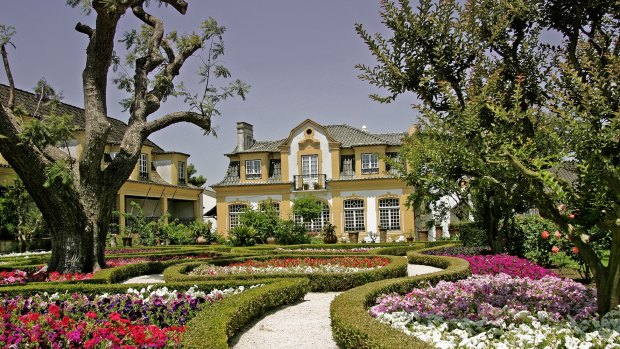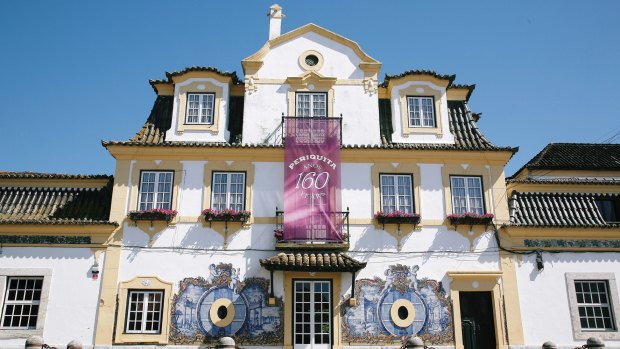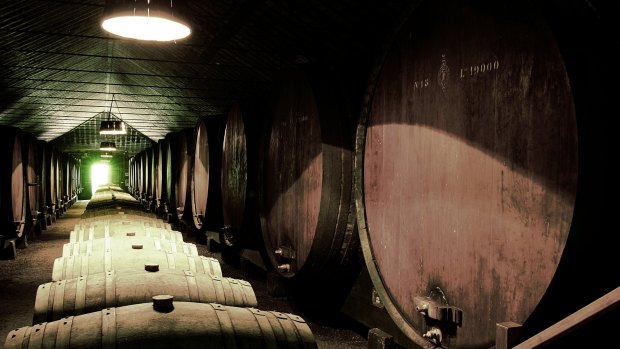This was published 8 years ago
Jose Maria da Fonseca winery museum, Lisbon: Legend of the Portuguese wine industry
One man was behind the first Portuguese wine to be sold in bottles and his family business is still going strong.
By Steve Meacham

The gardens and main building of the Jose Maria Da Fonseca winery and museum.
Ask the average Australian wine snob which Portuguese sips they're happy to sup and they'll probably sniff something along these lines: "Port, obviously. Madeira, possibly. And vinho verde only if it is drunk in Portugal, and only then when accompanied with fresh sardines and a hunk of bread or some other form of seafood."
Clearly such snobs have never visited the picturesque Jose Maria da Fonseca wine museum in charming Azeitao, 40 minutes' drive from Lisbon.
The man who gave his name to this winery/museum is one of the legends of the Portuguese wine industry, the founder of an eponymous family-run company now employing the sixth generation of his descendants.

Jose Maria Da Fonsceca.Credit: Steve Meacham
Born in 1804, Fonseca set up his first winery in the Setubal district south of Lisbon when he was 30. His reputation was secured with two types of wine – Setubal Moscatel and Periquita – which he created within a year of each other in 1849-50.
We know this because we're on a seven-day luxury coach tour, meandering through Portugal and Spain, and this visit to the Fonseca museum is one of the "Signature Experiences", which Insight Vacations builds into its itineraries each day. The idea is to take guests off the beaten track and give them a more intimate appreciation of the country they're travelling through.
Even from the street, it's obvious Fonseca is special. What was built in the 19th century as Azeitao's manor house was given a complete makeover in 1923 by a celebrated Swiss architect, Ernesto Korrodi, which explains the ornate yellow-and-white facade.

The Adega da Mata wine cellar.Credit: Steve Meacham
Inside we are greeted by Fonseca's guide, Rita. She explains that she's going to take us to the property's three ancient wine cellars – Adega da Mata, Adega dos Teares Novos and Adega does Teares Velhos – so that we understand why Jose Maria was such an outstanding entrepreneur.
In Jose Maria's heyday, Portugal still had an empire and the winemaker realised there were profits to be made shipping his vintages to the colonies, particularly Brazil. Rita explains that the moscatel (or muscat) grape has a particularly aromatic flavour with high sugar levels, which makes it ideal for refining into sweet, fortified wines – and fortified wines are better able to survive long sea journeys.
Unfortunately, not all Jose Maria's wine sold in Brazil. So, having endured one journey across the choppy Atlantic, barrels of the stuff were returned.
In theory, the wine should have deteriorated. After all, it had crossed the equator twice and been subjected to constantly changing temperatures and the pounding motion of the ocean. But to Jose Maria's amazement, the wine had decidedly improved. The double sea voyage in mahogany barrels had accelerated the maturing process, achieving in months what would have normally taken years.
Jose Maria marketed the much-travelled wine as Torna Viagem (or "return journey"), and it proved very popular.
It's a nice story, but was the wine really that much superior? Rita tells us that in the year 2000, Jose Maria's descendants decided to put it to the test. Six 600-litre casks of the company's 1984 moscatel were loaded onto a tall ship owned by the Portuguese navy. Off it sailed to Brazil – and back again. Sure enough, when the casks were opened, the wine had improved in the same way. Sadly, Rita says, there's no way of reproducing the effect in the winery.
Torna Viagem isn't for sale, but you can buy Setubal Moscatel, which hasn't made the sea journey. Likewise, the company is still making its Periquita label – reputedly Portugal's oldest brand of table wine.
The name comes from a property that Jose Maria bought in 1846, Cova da Periquita. It was here that he first experimented with the red Castelao grape, the basis of the Periquita blend, the first Portuguese wine, Rita tells us, to be sold in bottles. Previously wines were sold in barrels and could be watered down by unscrupulous victuallers. But Jose Maria learnt how the French were using bottles and corks and brought the technology to Portugal.
Then it's off to the three historic cobweb-filled cellars. In one, we see the valuable barrels of Torna Viagem; in another, massive mahogany barrels each the size of a family car.
At the very end of the last cellar is a padlocked metal gate that looks as if it has come from a church. It is fitting, Rita says, because this building, dating from 1750, is regarded as "the cathedral of muscatel". Behind the gates are kept the company's most valuable wines.
All this wine touring is thirsty work. Though it's only 11am, we head for the museum's shop to taste some of the 30 different types of wine the family now produce. They all bear the one name.
You get the feeling Jose Maria da Fonseca would be proud of what his family has achieved.
TRIP NOTES
MORE INFORMATION
GETTING THERE
Emirates has three daily flights from Sydney and Melbourne via Dubai to Lisbon and Madrid. See emirates.com/au
TOURING THERE
Insight Vacations' 10-day Country Roads of Portugal visits Lisbon, Portimao, Evora, Tomar, Douro Valley and Porto, and includes a visit to Jose Maria da Fonseca winery museum. From $2625 per person, twin share (single supplement from $780). See insightvacations.com
The writer travelled as a guest of Insight Vacations.
Sign up for the Traveller Deals newsletter
Get exclusive travel deals delivered straight to your inbox. Sign up now.